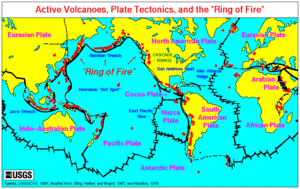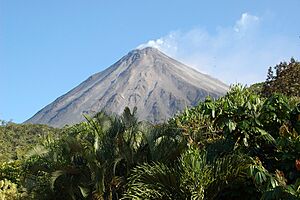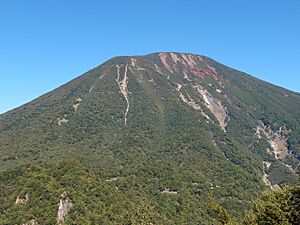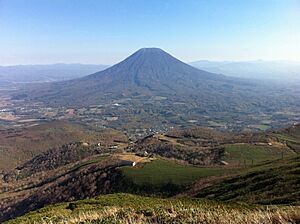Active volcano facts for kids
An active volcano is a volcano that has erupted recently, is erupting right now, or could erupt again in the future. If a volcano hasn't erupted lately but might in the future, it's called a dormant volcano. Volcanoes that won't ever erupt again are known as extinct volcanoes. The "recently" part means anytime in the last 11,700 years!
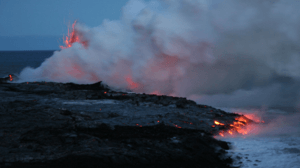
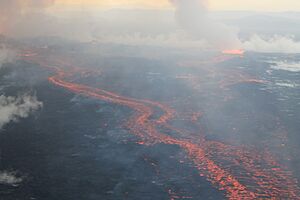
Contents
What is an Active Volcano?
There are about 1,350 volcanoes around the world that could erupt. About 500 of these have erupted in recorded history. Many active volcanoes are found along the Pacific Rim. This area is also known as the Pacific Ring of Fire. It's estimated that 500 million people live close to active volcanoes.
When we talk about "historical time" for volcanoes, it means how far back people have written down records of eruptions. This time period is different for various parts of the world. For example, in China, records go back almost 3,000 years. But in places like Hawaii, records only go back about 200 years.
Where are Most Active Volcanoes?
The Smithsonian Institution's Global Volcanism Program keeps track of volcanoes. Here are the countries with the most volcanoes that have erupted in the last 11,700 years:
- United States: 165
- Japan: 122
- Russia: 117
- Indonesia: 117
- Chile: 91
And here are the countries with the most volcanoes that have been active since 1960:
- Indonesia: 55
- Japan: 40
- US: 39 (mostly in Hawaii, Alaska, and Pacific areas)
- Russia: 27
- Chile: 19
Earth's Most Active Volcanoes
As of 2013, some of Earth's busiest volcanoes include:
- Kīlauea in Hawaii: This famous volcano had lava flowing almost non-stop from 1983 to 2018. It also had the longest-observed lava lake.
- Mount Etna and nearby Stromboli: These are two active volcanoes in the Mediterranean.
- Piton de la Fournaise: Located in Réunion, this volcano erupts often. It's even a popular tourist spot!
Some volcanoes have been erupting for a very long time, even if not continuously. As of 2010, these include:
- Mount Yasur: 111 years
- Mount Etna: 110 years
- Stromboli: 108 years
Other highly active volcanoes around the world are:
- Mauna Loa in Hawaii: This is the largest active volcano on Earth. Its top is over 4 kilometers (2.5 miles) above sea level. Its base is 17 kilometers (10.5 miles) below sea level on the ocean floor.
- Mount Nyiragongo and Nyamuragira: These are Africa's most active volcanoes.

- Erta Ale: In the Afar Triangle, this volcano has had a lava lake since at least 1906.
- Mount Erebus: In Antarctica, this volcano has had a lava lake since at least 1972.
- Whakaari / White Island: This volcano in New Zealand has been releasing volcanic gas since before Europeans first saw it in 1769.
Active Volcanoes Near Cities
Some active volcanoes have many people living very close to them. For example, the Michoacan-Guanajuato volcano in Mexico and the Tatun Volcanic Group in Taiwan both have over 5 million people living within 5 kilometers (about 3 miles) of them.
Active Volcanoes by Country
Here are some examples of active volcanoes in different countries.
Costa Rica
Costa Rica is home to several active volcanoes, many of which are stratovolcanoes. These are cone-shaped volcanoes built up by many layers of hardened lava and ash.
Iceland

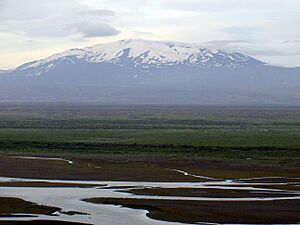
Iceland is known for its many active volcanoes due to its location on a tectonic plate boundary.
- Askja: A stratovolcano.
- Bardarbunga: Another stratovolcano.
- Fagradalsfjall: A fissure vent, meaning lava erupts from a crack in the ground.
- Hekla: A famous stratovolcano.
- Grimsvotn: A caldera, which is a large basin-shaped volcanic crater.
Italy
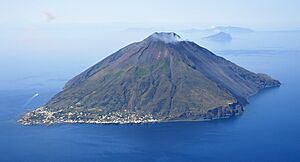
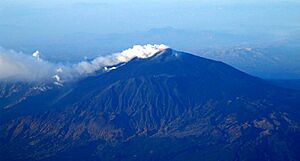
Italy has some of the world's most famous active volcanoes.
- Campi Flegrei: A large caldera near Naples.
- Etna: A very active stratovolcano on Sicily.
- Stromboli: A stratovolcano known for its frequent, small eruptions.
- Vesuvius: A stratovolcano near Naples, famous for burying Pompeii.
Japan
Japan is part of the Pacific Ring of Fire, so it has many active volcanoes.
- Mount Fuji: A famous stratovolcano on Honshu.
- Mount Aso: A large caldera on Kyushu.
- Mount Usu: A stratovolcano on Hokkaido.
- Izu-Ōshima: A volcanic island.
Mexico
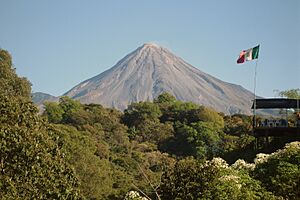
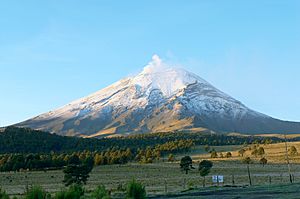
Mexico also has many active volcanoes.
- Colima: A stratovolcano.
- Popocatepetl: A large stratovolcano near Mexico City.
- Nevado de Toluca: Another stratovolcano.
Philippines
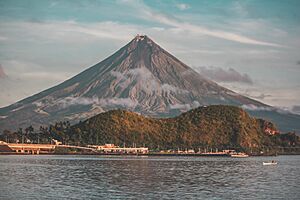
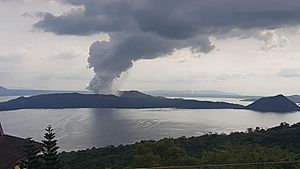
The Philippines has many active volcanoes, often found on islands.
- Mayon: A beautiful, cone-shaped stratovolcano.
- Taal: A caldera with a lake inside it.
- Pinatubo: A stratovolcano famous for its large eruption in 1991.
United States
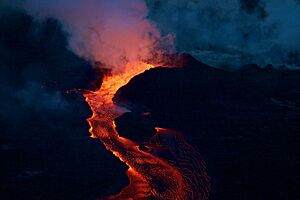
The United States has many active volcanoes, especially in Hawaii, Alaska, and the Pacific Northwest.
Hawaii
Hawaii's volcanoes are mostly shield volcanoes, which are wide and gently sloping. They are formed by very fluid lava flows.
- Kīlauea: A very active shield volcano.
- Mauna Loa: The world's largest active volcano.
- Hualālai: Another shield volcano.
Oregon

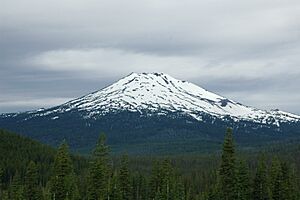
Oregon has a mix of stratovolcanoes and volcanic fields.
- Mount Hood: A stratovolcano.
- Mount Jefferson (Oregon): Another stratovolcano.
- Newberry Volcano: A complex volcano with a caldera.
Washington
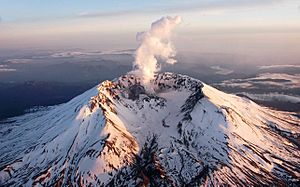
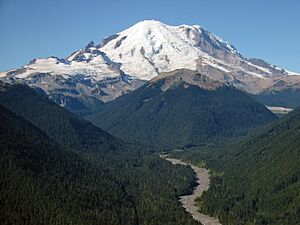
Washington State is home to several large stratovolcanoes.
- Mount Saint Helens: A stratovolcano famous for its 1980 eruption.
- Mount Rainier: A large stratovolcano.
- Mount Baker: Another stratovolcano.
California

California has various types of active volcanoes, including stratovolcanoes and lava domes.
- Mount Shasta: A large stratovolcano.
- Lassen Peak: A large lava dome.
- Long Valley Caldera: A very large caldera, sometimes called a supervolcano.
See also
- Monogenetic volcanic field
- Polygenetic volcanic field
- Category:Active volcanoes
- Category:Potentially active volcanoes


